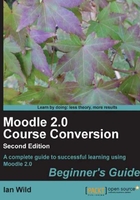
Course structure and format
Courses are divided into sections. What constitutes a section depends on the course's format. If you're new to Moodle then there are two main, important formats:
For your first few courses, especially courses based on existing non-e-learning material, these are likely to be the only two you use. However, there are others:
- SCORM: Third-party e-learning materials are likely going to be supplied to you in SCORM format (SCORM is an educational resource "standard" format, in much the same way that documents are supplied in "
.DOC" format). If you know what they are then this is a useful course format type. If you've never heard of SCORM then don't worry. - Social format: The whole course is built around a single forum. This is useful for using Moodle to manage things that are not strictly courses. You could use it to set up a departmental notice board, or a discussion forum for an after-school club, for revision, or (as in one school I worked in) to help organize the Year 11 prom.
To put your course into Moodle, you will need to select a format appropriate for your course structure and material.
Which format should we use: Weekly or topic format
First, here are the main differences between weekly and topic formats.
Topic formats:
- Consist of a fixed number of weeks – eachach section is exactly one-week long
- Has a definite start date – each week is given a precise set of dates, not "Week 1", "Week 2", and so on, but "March 3 – 10"
- A maximum of 52 weeks per course
- Remember to include term breaks if you have a course that covers two terms
So, when should you use each one?
Topic formats are usually best when:
- Students learn at their own pace or are self-directed in their learning – they will pick and choose resources from across the course, without any particular order being imposed
- The course is broken up into topics that come one after the other, but don't each last one week
- There are optional topics that not all students will study, or will be studied at different times
- Different groups of students will be using the course at different times
Weekly formats are usually best when:
- There is a clearly defined schedule
- The course has a defined start date
- You want to reinforce particular deadlines with the students (although in a weekly format course you can still access all of the materials and activities any time you like)
If you are new to Moodle then, at least to start with, I would stick with a topics format course. When I first started teaching I used to try and plan what I was going to teach that term, but it all went rapidly out of the window as I had to judge what subject areas I was going to move on to next, all depending on how the class were getting on with what we had covered so far. The same is true with Moodle and that's certainly why it's rare to find a Moodle course using the weekly format in a school or college.
Weekly format is ideal if are converting a course in which your students need their time planned out for them and you, as their teacher, know what is going to be coming up in the course and when. With a weekly course, your students have the chance to look on ahead and they'll know when to brace themselves for difficult/extra work if needs be. Also, if you are converting courses to support apprenticeships or students on work placement, have a think about whether a weekly format course would be the better option.
Breaking your course up into topics
You've now decided on a course, but you need to break the course up into Moodle topics. The most common ways of achieving this are:
- By sequence: Some kind of narrative order. Basically, follows the order in which the reader should learn
- By resource type: Worksheets, handouts, web resources
- By "true topic": Each section collects resources on one topic within the course, even though the course doesn't necessarily progress through those topics in order
Each has pros and cons. Each has situations where they are ideal.
You can even combine them, say, have a bunch of topics that map to an ordered set of units, with some non-ordered units at the end that cover, for example, resources relating to a private study project that runs throughout the course.
I've broken up my Backyard Ballistics course into five topics because that's how it is structured before I've converted it to Moodle, and five topics was a natural fit.
If you are worried about how you should structure your courses when you convert to Moodle then remember that you can always come back and change things later on. Often it is easier to start getting courses converted to Moodle and the very act of doing so will help you see how things should be organized.